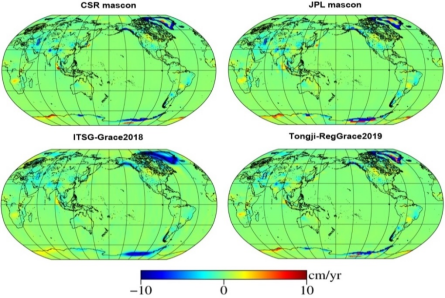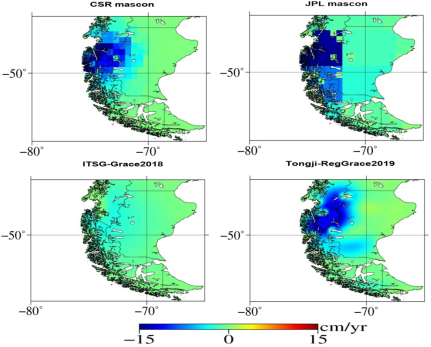High-Resolution GRACE Month Spherical Harmonic Solution
Qiujie Chen, Yunzhong Shen, Jürgen Kusche,
Wu Chen, Tianyi Chen, Xingfu Zhang
The global unconstrained time-variable gravity field model derived from GRACE (Gravity Recovery and Climate Experiment) Level 1B data is the only means to quantitatively evaluate the changes of large-scale surface mass migration, such as changes in global land water storage, sea level changes, polar ice caps and mountain glaciers melting, and earthquake coseismic variation. At present, the global time-variable gravity field models are mainly unconstrained spherical harmonic coefficient models, such as CSR RL06 from CSR (Center for Space Research), and JPL RL06 from JPL (Jet Propulsion Laboratory), and GFZ RL06 from GFZ (GeoForschungsZentrum). Unconstrained spherical harmonic models contain stronger high-frequency noise and correlated noise, which means that they depend on certain filtering methods, such as Gaussian smoothing, decorrelation filtering, and DDK filtering. Although these filtering methods can significantly reduce the correlated noise, however, it also brings some signal leakage and spatial leakage, which greatly restricts the improvement of the spatial resolution of the gravity field model. Because of the shortcomings of unconstrained spherical harmonic models, high-resolution mascon solutions time-variable gravity field model developed by some research groups including CSR, JPL, and NASA GSFC by expressing the spherical harmonic model as a spatial mascon grid and taking into account the spatial constraints of the mascon grid.
Theoretically, the spherical harmonic coefficient model is equivalent to the mascon model, because the mascon model only changes the gravity field signal into the grid form for expression, and the core is to draw into the spatial constraints of the gravity field signal. In view of the low spatial resolution of the GRACE unconstrained spherical harmonic coefficient model, recently, the satellite gravity team of Tongji University deeply analyzed the Spatio-temporal characteristics of mass changes in the ocean, land, and sea-land interface, and constructed the variance-covariance matrix of the global grid mass change signal; Then, the variance-covariance matrix of the quality change signal is converted to the spectral domain to form the spectral constraint matrix of the spherical harmonic coefficient model. Based on the spectral constraint matrix of the spherical harmonic coefficient model and the theory of canonical solution, we processed the GRACE Level 1B satellite data from April 2002 to December 2016, forming a time resolution of 1 month and a spatial resolution of about 1o×1o high-resolution time series Tongji-RegGrace2019 spherical harmonic coefficient model up to degree and order 180.

Figure 1.Trends of global mass changes
As shown in Figure 1, the CSR RL06 mascon and the JPL RL06 mascon solutions are close to Tongji-RegGrace2019 in terms of signal power and signal spatial distribution. The model noise and signal space leakage are effectively suppressed, and the spatial resolution of the gravity field signal is improved. Specific to local areas, taking groundwater changes in northwest India as an example, Tongji -RegGrace2019 model is very consistent with CSR mascon, JPL mascon, and WGHM groundwater models, which reveals that there is obvious groundwater subsidence in northwest India.

Figure 2. Groundwater change trends over Northwest India
To compare the distinctions of mass transport estimates among various models, we selected the Amazon River, Ob River, Mississippi River, Mekong River, and Orange river for comparative analysis, the time series of mass changes over the Amazon River basin from the GRACE solutions and hydrology models are shown in figure 3, which can conclude that the spatial signal pattern from Tongji-RegGrace2019 is comparable to those from CSR and JPL mascon models. The amplitude of mass change and correlation coefficients of mass changes between Tongji-RegGrace2019 and others in different basins are presented in Table 1, one can see from Table 1 that the signal power of CSR and JPL mascon solutions are close to Tongji-RegGrace2019.

Figure 3. Time series of mass changes over Amazon
Table 1. Results (Amp Indicates Annual Amplitude in Unit of cm; Cor Means Correlation Coefficient between TongjiRegGrace2019 and Others) Over River Basins (A: Ob; B: Mississippi; C: Mekong; D: Orange; E: Amazon) Based on GRACE Solutions and Hydrology Models
Area |
CSR mascon |
JPL mascon |
ITSG-Grace 2018 |
GLDAS |
WGHM |
Tongji-Reg Grace2019 |
Amp | Cor |
Amp | Cor |
Amp | Cor |
Amp | Cor |
Amp | Cor |
Amp | Cor |
A |

|

|

|

|

|

|
B |

|

|

|

|

|

|
C |

|

|

|

|

|

|
D |

|

|

|

|

|

|
E |

|

|

|

|

|

|
To investigate the ability of the different GRACE solutions in the detection of polar ice sheet mass loss signal, three ice sheets Greenland, Antarctica Peninsula, and Patagonia are analyzed, Figure 4 shows the time series of mass changes over Antarctica Peninsula and Patagonia. Overall, the high-resolution model Tongji-RegGrace2019 is very consistent with CSR mascon and JPL mascon models. Figure 5 shows the time series of mass loss trend of different models in the Patagonian ice sheet, and we can see that Tongji-RegGrace2019 high-resolution model is closer to the CSR mascon model. In a word, the high-resolution model Tongji-RegGrace2019 is completely comparable to the high-resolution mascon model developed by CSR and JPL, indicating that mascon modeling is theoretically equivalent to spherical harmonic coefficient modeling.

Figure 4.Time series of mass changes from GRACE models
(a)Antarctica Peninsula; (b) Patagonia

Figure 5. Trand maps of mass changes over Patagonia
This study is primarily sponsored by the Alexander von Humboldt Foundation in Germany, the National Natural Science Foundation of China (41731069 & 41674006), and the National Key R&D Program of China (2017YFA0603103).
Citation:
Chen Qiujie, Shen Yunzong, Jürgen Kusche, ChenWu, Chen Tianyi, Zhang Xingfu (2020).High-resolution GRACEmonthlyspherical harmonicsolutions. Journal of Geophysical Research, 121(1),https://doi.org/10.1029/2019JB018892.

